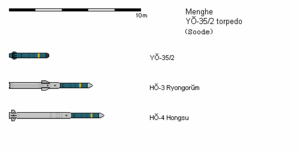HŎ-4 Hongsu
| HŎ-4 Hongsu | |
|---|---|
 | |
| Type | Anti-submarine missile |
| Place of origin | Menghe |
| Service history | |
| In service | 2017-present |
| Specifications | |
| Weight | 1,640 kg |
| Length | 7.2 m |
| Diameter | 350mm (nose) 510 mm (base) |
| Warhead | YŎ-35/2 torpedo |
| Engine | Solid-fuel rocket |
Operational range | 75 km |
Guidance system | Inertial guidance |
Launch platform | Submarines |
The HŎ-4 Hongsu ("Flood") is a submarine-launched anti-submarine missile developed in Menghe in the 2010s. It carries a YŎ-35/2 torpedo out to a range of 55 kilometers, dropping it into the last known location of an enemy undersea target. It can be fired from a standard 533mm torpedo tube, or from a vertical-launch tube in certain submarine classes.
Development
The HŎ-4 is the direct successor to the HŎ-2 Poksŏl, which was designed to be fired from submarine and surface ship torpedo tubes. While the HŎ-3 Ryongorŭm replaced this system on surface ships, it could only be fired from launch cells in the Mark 41 Vertical Launching System: because its mid-fuselage fins fold against the missile body to form a square cross-section, it cannot be fired from torpedo tubes.
Description
In terms of overall layout and principle the HŎ-4 is similar to the HŎ-2 preceding it. Upon reaching the surface, it fires a solid-fuel rocket booster and follows a ballistic trajectory toward the target coordinates, using an inertial guidance system to remain on course. In the final phase of the projectile's descent, the forward torpedo section breaks off, and both the spent booster and the torpedo descend to the surface of the sea slowed by parachutes to soften the noise from their impacts. On landing in the water, the YŎ-35/2 torpedo performs a single low-speed loop on passive homing mode for a first attempt at detecting the submarine undetected. If this fails, the torpedo switches on its active seeker and continues to circle until it acquires the target or runs out of battery.
Apart from its increased range, the HŎ-4 also uses a slightly different launch procedure. Inside the submarine, it is stored in a 533mm watertight container prior to launch. On firing, the container is ejected from the launch tube by compressed water like a standard torpedo, then floats to the surface, led by its less dense nose section. As the top of the container reaches the surface, the rocket fires, moderately reducing underwater noise and reducing the exposure of the missile to the elements.
Even with these quieting measures, the HŎ-4 generates a considerably louder acoustic launch signature than a YŎ-53/05 torpedo. As such, it is intended for use in situations where the submarine commander is willing to risk detection: for example, engaging a transient and time-sensitive target, or engaging after the launch platform has already been detected. A commander may also fire a HŎ-4 after detecting an incoming wire-guided torpedo as a means of forcing the other commander to rapidly change position, breaking the guidance wire in the process.